|
| |
Kanu  Links Links
ATVs and Their Impact on Cross Country Ski Trails
| ATV have arrived here about
20 years ago and have somewhat matured into affordable and reliable technology. They are 4-wheel drive vehicles, with large and soft
knobby tires so they grip well on varied terrain. They are both a plaything and a work
horse, and their popularity is growing rapidly. They also are a major threat to the
well-being of our northern environment. Even though they have small engines, many still
use 2-cycle engines, have no effective pollution controls and release significantly more
pollution per mile travelled than your family car. Add to that the high torque that the
engine/transmission generates, and you will realize that this thing can chew up the ground
really. A skilled and careful operator can minimize such damage. But on some types of
terrain, such as hills and in wet areas, damaging the soil and vegetation is unavoidable.
affordable and reliable technology. They are 4-wheel drive vehicles, with large and soft
knobby tires so they grip well on varied terrain. They are both a plaything and a work
horse, and their popularity is growing rapidly. They also are a major threat to the
well-being of our northern environment. Even though they have small engines, many still
use 2-cycle engines, have no effective pollution controls and release significantly more
pollution per mile travelled than your family car. Add to that the high torque that the
engine/transmission generates, and you will realize that this thing can chew up the ground
really. A skilled and careful operator can minimize such damage. But on some types of
terrain, such as hills and in wet areas, damaging the soil and vegetation is unavoidable. |
Northern Ontario, a beautiful country of mature forests and clear
lakes. Folks from all over the province and even further away come to enjoy this
area. Not just canoeing, fishing and hunting in the snow-free months, but winter had folks
snowshoeing and skiing to get into the secret nooks of the forest. Some skiing trails were
established twenty or thirty years ago. But times changed since and modern times brought
the ATV into the country and with it a serious threat to the old trails. |
Even though there are careful riders, there
are plenty of yahoos a mongst
the ATV community that don't care. The industry is not helping either, with their
commercials that advocate boisterous freedom for the rider as the ATVs criss-cross the
wilderness. Last not least, where one vehicle may have nearly no impact, repeated travel
over the same spot will start the damage. mongst
the ATV community that don't care. The industry is not helping either, with their
commercials that advocate boisterous freedom for the rider as the ATVs criss-cross the
wilderness. Last not least, where one vehicle may have nearly no impact, repeated travel
over the same spot will start the damage.  |

| In late October 2003, I walked one of these ski trails to document how
ATV usage changes the trails. What I found was disheartening: the formerly smooth trail
has changed and has becomes a hazard to the skier and a challenge to the
groomer who has to negotiate the trail with his heavy machine. |
And the trail multiplies into parallel threads - the forest
canopy is starting to open up to admit animals and plants that typically are
found on the forest fringes and now displace the deep forest dwellers. |
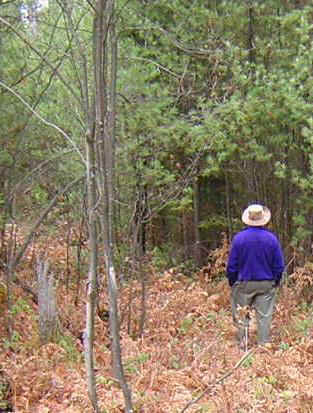
|
That's what the trail looked like before ATVs were running on it.
Vegetation is intact, the soil is undisturbed and the forest canopy is still closed. A
healthy trail in a healthy forest... |
The Ski Trail after a few years of ATV
travel:
One of the lodges has started to market ATV rides and thus its customers
now travel on the old ski trails. |
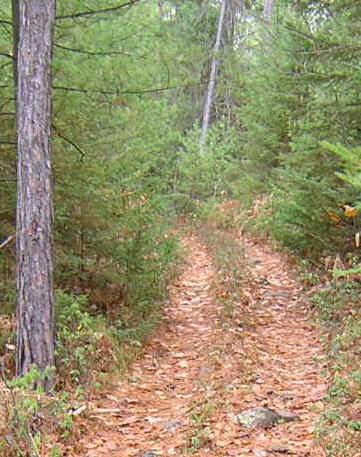
|
That's what it looks like in many sections. Here, onl
evel ground, the former ski trail has not changed in width but the trail surface shows
wear from the ATVs tires. The rocks near the surface are starting to show and the
vegetation has died on the track surface. The scene is set for erosion to take its
toll. |
| Damage to the Ski Trail on Hills: A
downhill bend has washed out to become a rocky stream bed, a into hazard for skier in the
shoulder seasons. An uphill curve has evolved into a creek bed and has started to erode so
badly that broken rock is revealed. |
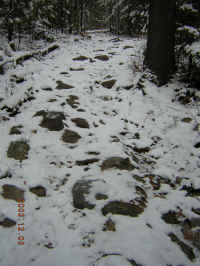
Click on the image to see the effect that the erosion has
on the trail. Again, this section will become a hazard to the skier until the snow cover
is sufficiently thick to hide the obstacle. Worse, meltwater run-off underneath the snow
will create a hidden hole and unexpected ice may surprise the unwary skier.
|
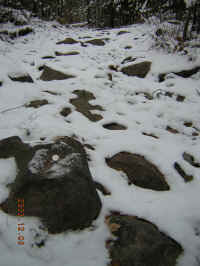
And to get a true feel for the size of the rocks, here's a close-up:
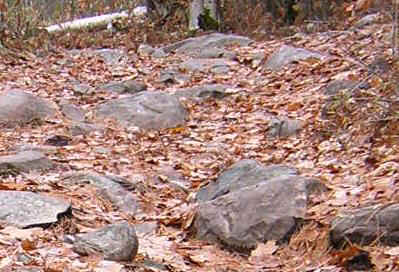 This is the same spot without the snow. Click on the image to enlarge it. This is the same spot without the snow. Click on the image to enlarge it.
|
| Three years later, Rain and snow melt have eroded that same spot to a
tricky boulder field: |
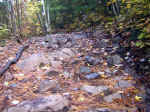 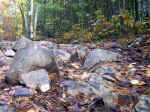 |
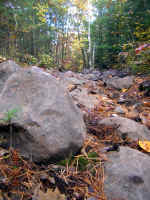 |
|
|
|
| Further along the trail, a huge bolder has been exposed that will give
the trail maintenance folks future headaches. The soil around a rock has
eroded and created a large hump that is a hazard to the skier in the times of shallow snow
cover. Click on the picture to see how the trail is impacted. If the erosion continues,
some trailwork will have to either remove the rock or rebuild the soil around it |
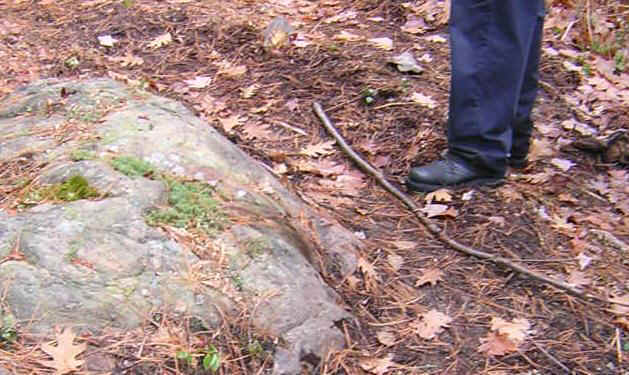 |
For the skier, it will need about two feet of snow to cover the danger
spots and make these places safe. Thus, a month or two of each skiing season will be lost
due to the damage on the trail. |
Damage to the Ski Trail in low-lying
areas:
Here the trail receives the worst damage. The ATV wheels soften the ground, chew it up and
progressively rut the surface. |
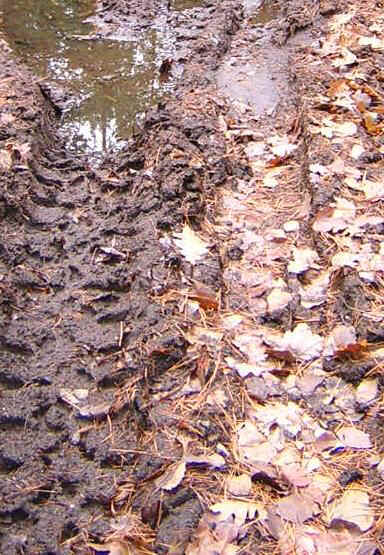
|
If the area is wet enough, huge mud holes start to form as wheels dig
deeper each time, and eventually the trail becomes impassable
even to the ATV. |
Here's a section with the typical pond that now has
formed.
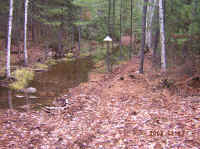
|
In winter, it freezes over, of course.
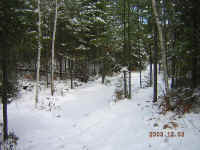 |
But it's a treacherous patch of ice: it is thin and
unpredictable. A skier can easily get into trouble, and the guy on the grooming machine will curse this spot when his machine breaks
through....
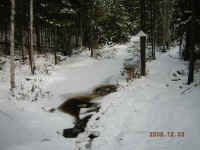 |
You guessed it: I tried to 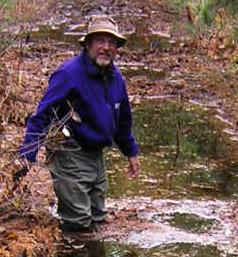 demonstrate the depth of the puddle by rolling up the pant
legs to step into the water, expecting something ankle-deep. I got a surprise: as I probed
for the bottom of the rut, I slipped and ended up knee-deep in the muck, much to the
amusement of my fellow hikers. demonstrate the depth of the puddle by rolling up the pant
legs to step into the water, expecting something ankle-deep. I got a surprise: as I probed
for the bottom of the rut, I slipped and ended up knee-deep in the muck, much to the
amusement of my fellow hikers. |
No kidding:
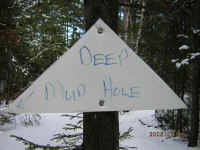
|
Once such a mud hole has formed, even ATV riders are loath to go
through it because they are afraid to get stuck. So, they search for a way around it, thus
creating a parallel section of the trail. In the pictures
above, that new branch is on the right. Another few seasons, we'll see an old mud hole on
the left and a chain of new mudholes on the right until some impatient rider will push a
third track a few metres further over..... |
| ....and so on, the trail becomes a
weave of parallel tracks and in the process the once closed forest opens
up and becomes vulnerable to invasion of forest edge species. This is maybe the most
damaging effect of the ATV on the area you ski in - in addition to the eroded trails, the exposed rocks and
the treacherous mud holes. So, direct the ATVs away from your ski trails and save the
trail and the forest!
|
| You have seen the damage from ATVs to ski
trails, but the damage goes much further in heavily used areas by changing the forest
itself. We all value nature, that's why we are out there in the first place.So, let's do something about it:
 | The ATV organizations have to
establish an ethic that will preserve the woods rather than destroy them.
|
 | The ATV industry has to be
pressured to manufacture less damaging machines - machines that produce
less noise and pollution and machines that do less damage to the soil
|
 | The MNR (in Ontario), as the
steward of our lands, has to recognize the threat and establish the tools that allows regulation
of the use of ATVs on crownland. Resources must be made available that fund the
enforcement of such rules.
Even though Ontario has not been pro-active in controlling ATV use, some
developments are encouraging in the newly created parks and conservation reserves. The MNR
does not explicitly prohibit ATV use on protected land but it reserves the right to do so
if necessary to protect the nature values. It's a small step only and it does not address
the damage on land outside of the protected areas.
|
 | And the soft-shoed public -
naturalists, skiers, hikers and canoeists - must speak up and work
towards stopping this rape of the land. |
|
If you are curious and would like to read more, here are
the Links to some of the players
(in Ontario at least)
- ATV Ontario, a roof
organization for ATV users
- MNR (Ontario's
Ministry of Natural Resources), meant to enforce sustainable use of our public lands
- MOE (Ontario's Ministry
of the Environment), responsible for stopping pollution
- Honda (they
have moved away from the big-time polluting two-stroke engines and there is an
acknowledgement that riders should practise environmentally friendly riding. No details
are given how that can be done, but maybe such education is attempted as part of Honda's
safe riding classes)
- Polaris
(they are no better than Bombardier - Nov. 2003)
Bombardier (they
are just selling without any mention of the environment - Nov 2003)
-
- FON
(Federation of Ontario Naturalists), active to protect nature, such as forests and
wetlands
- CPAWS (Canadian Parks and
Wilderness Society, with its Ontario chapter called the Wildlands League), dedicated to
stop destructive use of wetlands, forests and our special ecosystems
- WCA (Wilderness Canoe
Association), a paddling club that aims to preserve the wilderness experience
|
Back to Erhard's
Canoe Pages
|
 Links
Links ![]()
 affordable and reliable technology. They are 4-wheel drive vehicles, with large and soft
knobby tires so they grip well on varied terrain. They are both a plaything and a work
horse, and their popularity is growing rapidly. They also are a major threat to the
well-being of our northern environment. Even though they have small engines, many still
use 2-cycle engines, have no effective pollution controls and release significantly more
pollution per mile travelled than your family car. Add to that the high torque that the
engine/transmission generates, and you will realize that this thing can chew up the ground
really. A skilled and careful operator can minimize such damage. But on some types of
terrain, such as hills and in wet areas, damaging the soil and vegetation is unavoidable.
affordable and reliable technology. They are 4-wheel drive vehicles, with large and soft
knobby tires so they grip well on varied terrain. They are both a plaything and a work
horse, and their popularity is growing rapidly. They also are a major threat to the
well-being of our northern environment. Even though they have small engines, many still
use 2-cycle engines, have no effective pollution controls and release significantly more
pollution per mile travelled than your family car. Add to that the high torque that the
engine/transmission generates, and you will realize that this thing can chew up the ground
really. A skilled and careful operator can minimize such damage. But on some types of
terrain, such as hills and in wet areas, damaging the soil and vegetation is unavoidable.  mongst
the ATV community that don't care. The industry is not helping either, with their
commercials that advocate boisterous freedom for the rider as the ATVs criss-cross the
wilderness. Last not least, where one vehicle may have nearly no impact, repeated travel
over the same spot will start the damage.
mongst
the ATV community that don't care. The industry is not helping either, with their
commercials that advocate boisterous freedom for the rider as the ATVs criss-cross the
wilderness. Last not least, where one vehicle may have nearly no impact, repeated travel
over the same spot will start the damage. 












